
An image from a coloring book by Daniel Mitsui
The distinguished Catholic artist Daniel Mitsui sent me three prints of saints whose feast days are not very far off. As usual, in his inimitable style, his images present both awe and whimsy.
BUT FIRST… a touching story…
After Mass last Sunday a fellow stopped in at the sacristy to say hello and to bring news, since I have been away quite a bit with travel and the like. He and his wife have been giving special attention to a highly educated woman, now badly reduced with Parkinson’s together with other complications. She has not been terribly open to the Catholic Church over the years, to put it mildly. However, my friend slowly but surely introduced religious matters as points of discussion. Moreover, as part of her therapy, they have been using Daniel Mitusi’s coloring books … which are decidedly not just for children. Some of the images are remarkably complex. Go and look! The imagery of the coloring books is a great entry point into any number of discussion topics about the Catholic Faith. To make a long story brief, she was received into the Catholic Church recently. Works of mercy and great patience played their roles, as did Daniel Mitsui’s marvelous coloring books.
Now, let’s have a look at the new prints Daniel sent.
Please note that I left the prints in their plastic covers. You can find more about the images at his site. HERE
St. Nicholas has a feast day on 6 December. The lightning and storm are given more shock value by the clear state of mind of the passengers in the boat. And is that an Anglerfish I see? Note that Nicholas is revered as a great patron by fisherman and others who go by sea.
15 November brings us St. Albert the Great, Doctor of the Church and a mentor to St. Thomas Aquinas… who has a cameo appearance in this print. Note that, on the shelf above the saint, is a strange “bust” that looks like Frankenstein. It reappears at the bottom in a scene of violence!
That’s St. Thomas, about to smash a mechanical head that St. Albert had made that could answer questions.
MY INTERPRETATION:
Here, the head, let’s nickname the head… “Laetitia“… is saying “SIC!… NON!”, which is to say, “Yep!… Nope!”. I take this to mean that Laetitia says “Yes” and “No” at the same time in the same respect, thus violating the Principle of Non-Contradiction. That would certain horrify Thomas to the point of bashing “Laetitia” in with a handy club. No? Imagine what the Angelic Doctor would do were the talking head to say, “5!” when asked what “2+2” equals?
Well… that’s my take.
That’s hilarious. Daniel wrote to me that, “That story captures the way I feel as a traditional Catholic using the internet – sometimes like one saint, and sometimes like the other.”
Surely he is right.
That said, I’m sticking with my own eisegetical version.
There are COLOR versions, too. But he doesn’t send those very often.
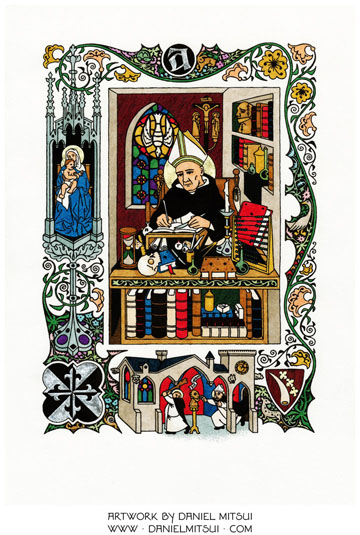
Also in November, 22 November to be exact, is the Feast of St. Cecilia, patroness of Church music. Here she is in a very dignified pose, with her little portative organ. The bellows are a nice touch.
These prints are not huge. They would be easily framed and would make beautiful gifts.

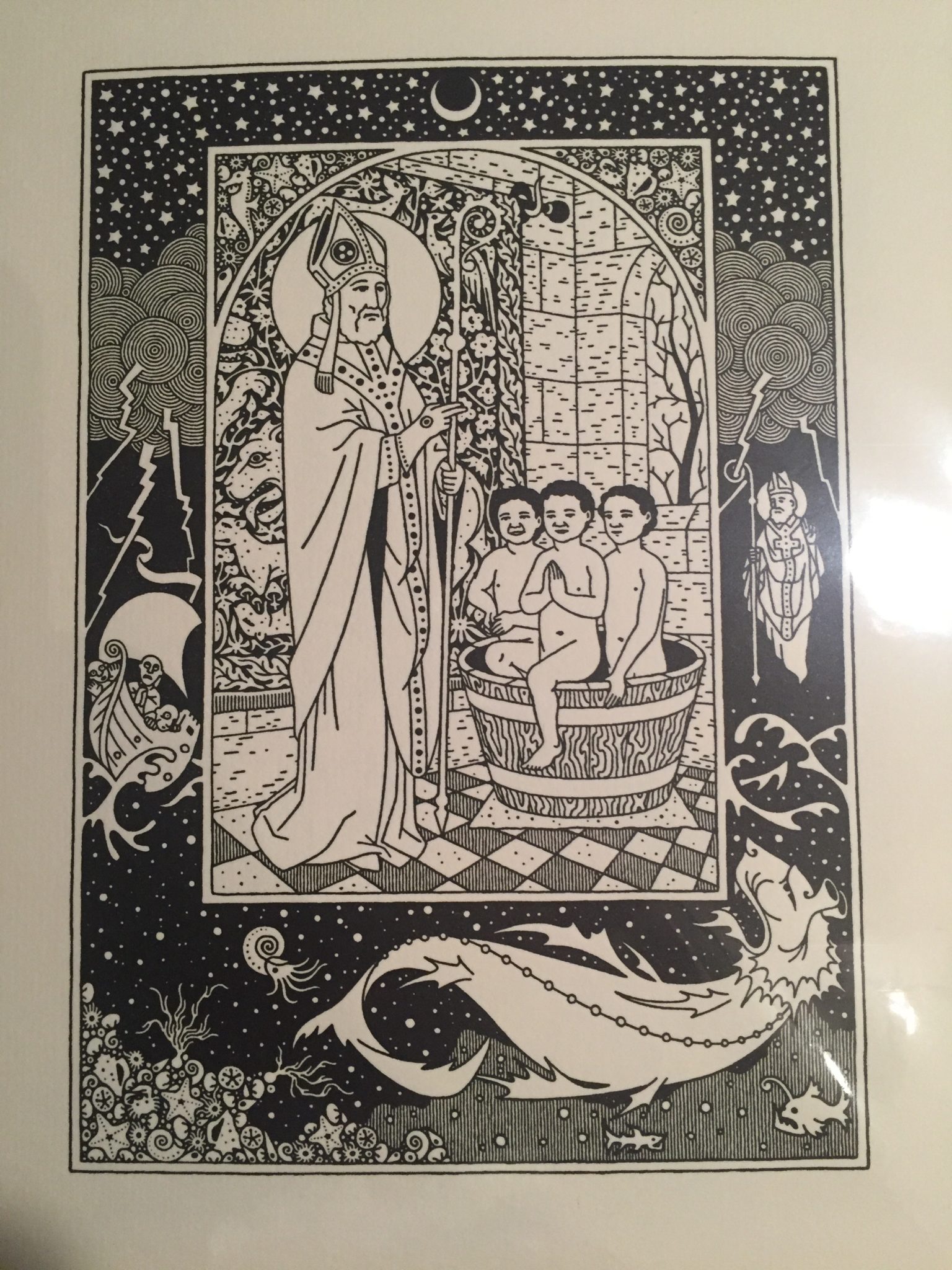
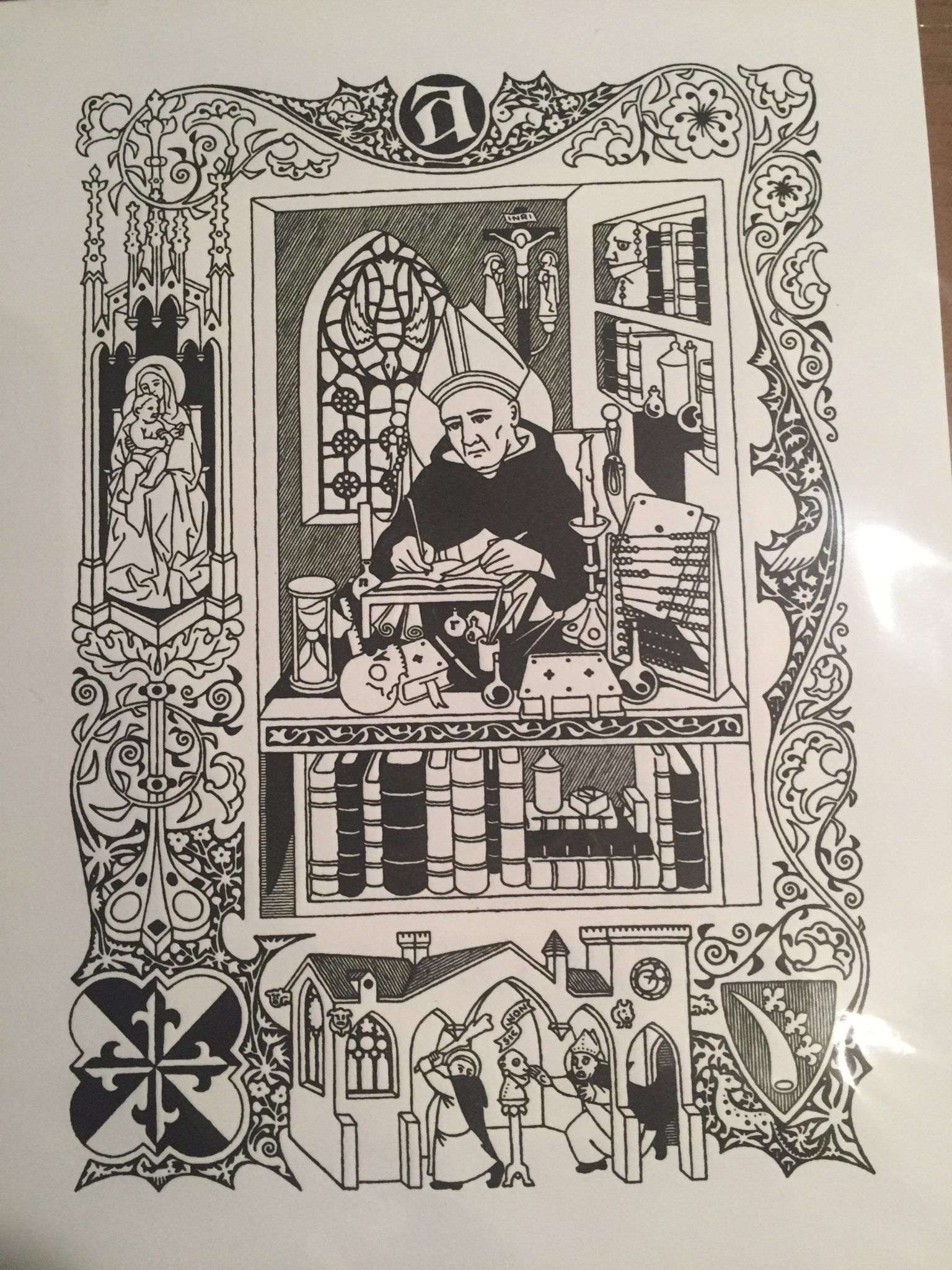
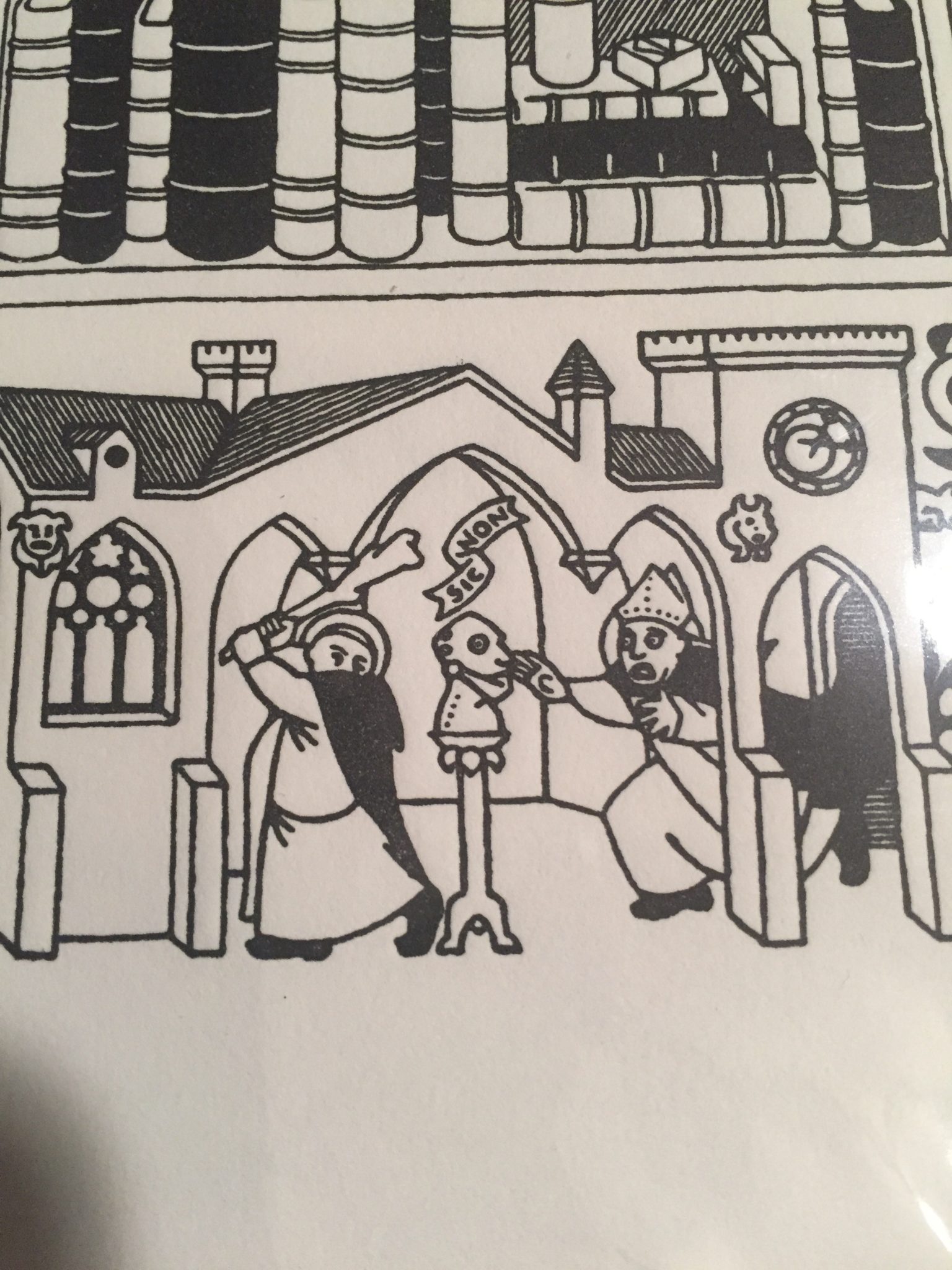
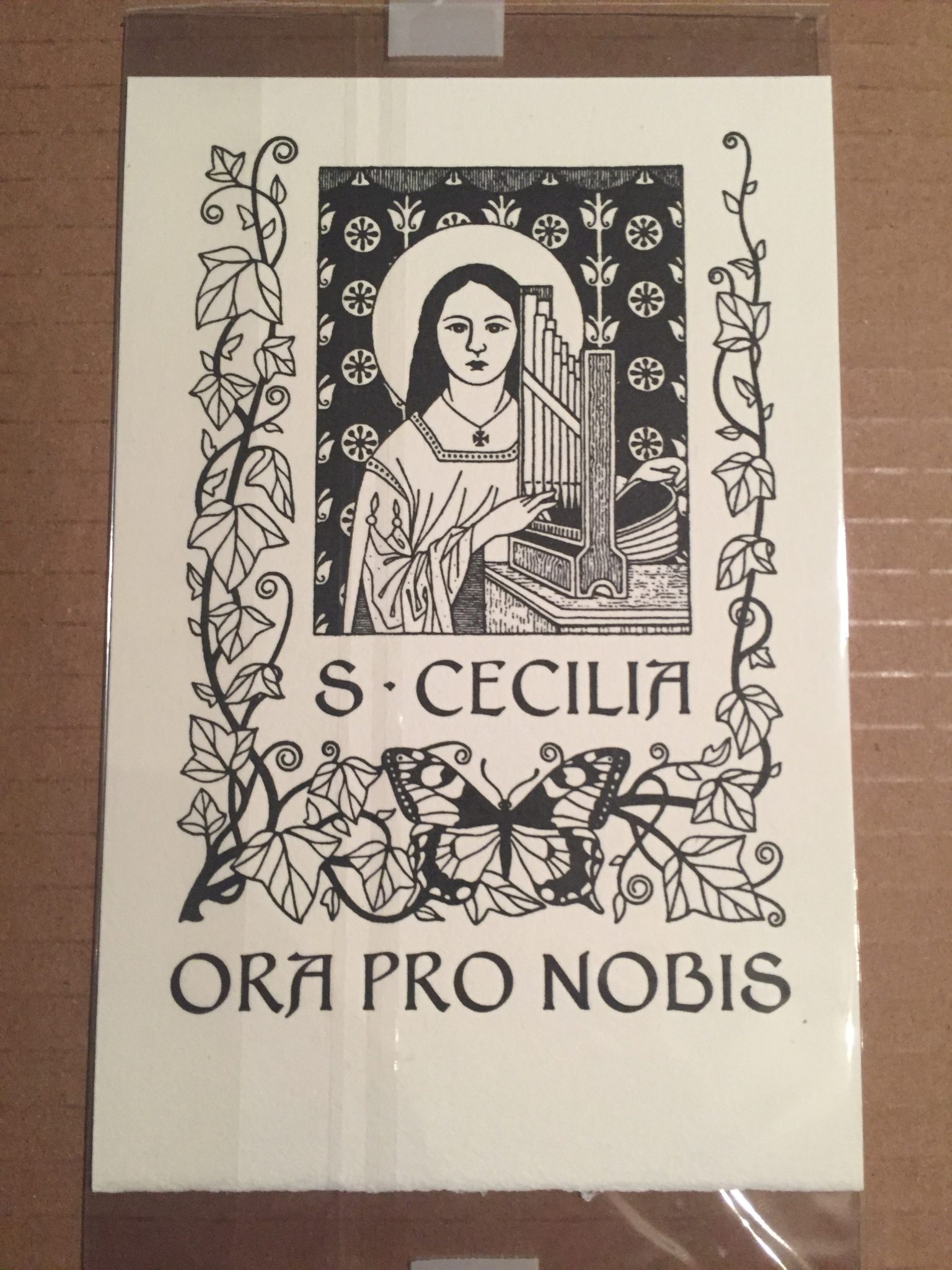

































Pingback: TVESDAY CATHOLICA EXTRA | Big Pulpit
The story as I have read it in a few places is that St Albert actually made a full-sized robot that could move as well as talk. When he showed it off to St Thomas, Thomas took fright and belted it with a stick, breaking it. I would love to know the source of this (improbable) tale.
People in the Middle Ages knew about the steam-powered automata of the Greco-Roman world, and they had all sorts of clever clockwork and mechanical devices as well as water-powered ones.
So there were some stories floating around about talking automata, too, and they tended to attach to either the Virgil “I’m a poet and an immortal magician/mechanic” stories, or to the various super-learned guy stories (like St. Albert or Friar Roger Bacon, or that mathematician pope guy). They also showed up in the “X university has a secret magical school run by the Devil” stories (so yep, the Brazen Head was allegedly at Salamanca, Paris, Bologna….).
The closest thing to these kinds of stories in the modern world is the sf/f tendency to use Shakespeare and Marlowe as action heroes, or for anime to keep using historical scientists to take over alternate worlds.
Daniel Mitsui is my favorite Catholic artist today! I love that one of my favorite priests is giving him a spotlight. We have two large prints in our home and several smaller ones–including the colored St. Albert–they are all magnificent framed and always garner attention from Catholics and nonCatholics alike. His vocation of art is truly evangelical mission work.
It would be nice to have a place for Catholic artists to get together. Paint, sculpt and draw together. Talk shop, trade secrets…..
Whether it is fitting to depict St. Thomas as a right-handed batter?
Obj. 1. It would seem fitting to depict St. Thomas as a right-handed batter.
The majority of baseball players – and, indeed, humanity – are right-handed. And St. Thomas represents, in a certain way, the collective wisdom of humanity, as Pope Leo XIII observes that “he seems to have inherited the intellect of all.” Therefore, it is fitting to depict St. Thomas as a right-handed batter.
Obj. 2. Further, right-handed batting is to be favored due to St. Thomas’ sanctity, which is nothing less than likeness to God. For the Psalmist has it that “The LORD says to my lord: ‘Sit at my right hand until I make your enemies a footstool for your feet.'” Moreover, Our Lord promised that “He will put the sheep on his right and the goats on his left.” (Mt 25:33). Therefore, it is fitting to depict St. Thomas as a right-handed batter.
On the contrary, “The eye is the lamp of the body. If your eyes are healthy, your whole body will be full of light.” (Mt 6:22).
I answer that, because vision is the superior faculty of sense when compared to touch, it follows that the hitter’s eye is more important than right-handedness; for right-handedness is a property of touch, while the hitter’s eye is a property of seeing. But intelligence, by which both the angels and the Angelic Doctor are most widely celebrated, is most like the eye; for the object of sight is the visible, and the object of the intelligence is truth, as the Philosopher says.
And here the term “right-handedness” obscures the truth, for a “left-handed” batter indeed places his right hand at the bottom, or controlling, part of the bat, and puts his right eye and right foot forward when swinging at the object. Thus, while all the greatest baseball hitters are all denominated “left-handed,” they in fact are “right-eyed,” so to speak.
Now, some say that the beatitudinous assemblage of left-handed hitters merely bears witness to the predominance of right-handed pitchers. But this merely proves that God, in His infinite wisdom, has ordained that right-handedness be the preferred method of pitching, not batting, and this as a reflection of His own righteousness and glory. For while it is impossible to ascribe to the inapproachable Divinity any baseball position per se, it is clear that the pitcher, as the prime mover of each play, partakes most in a Godlike aspect. Hence, as Bishop Sheen has it, “Out from the finger-tips of God there tumbled planets and worlds.”
From these principles we may say that it is most fitting to portray St. Thomas as a left-handed batter and a right-handed pitcher. This suffices to answer the objections.
Oh, well done, Mario! Very droll, indeed.
However, St. Thomas was so rectified in both his sight (intellectual virtues) and in his action (moral virtues) that he would rightly be said to have two right hands, for everything that he did, with both hands, would be “right”. (The opposite saying, of a person who “has two left [sinister] feet”, of course, refers to someone who does wrong no matter which way he tries to go.) Hence St. Thomas would of necessity be a right-handed batter, whichever stance he took. While photographically, we would have discovered that St. Thomas might have taken either stance as needed, in crafting a depiction, it would necessarily be one of a right-handed batter in order to not confuse the simple. Therefore, it is fitting that St. Thomas be depicted as a right-handed batter.